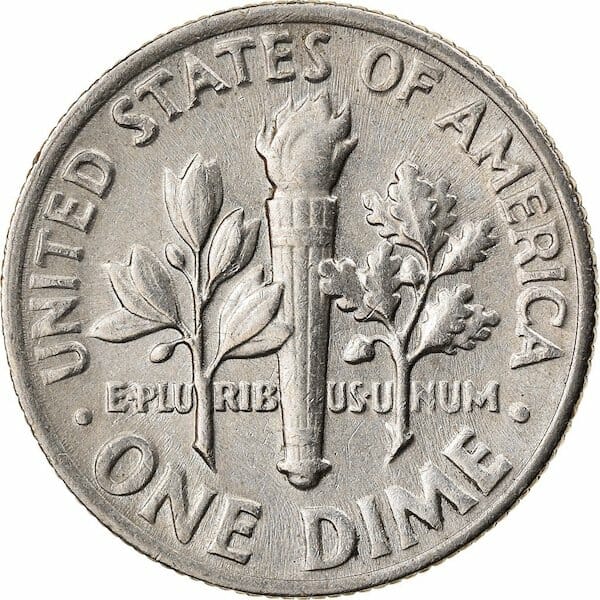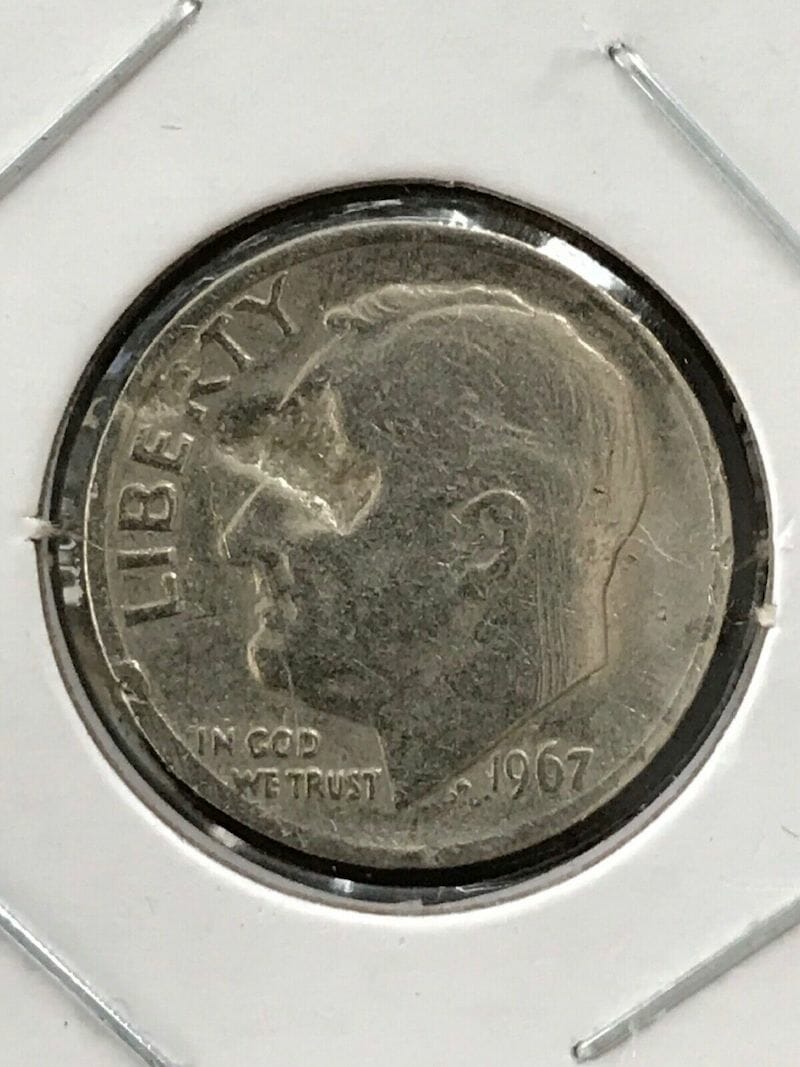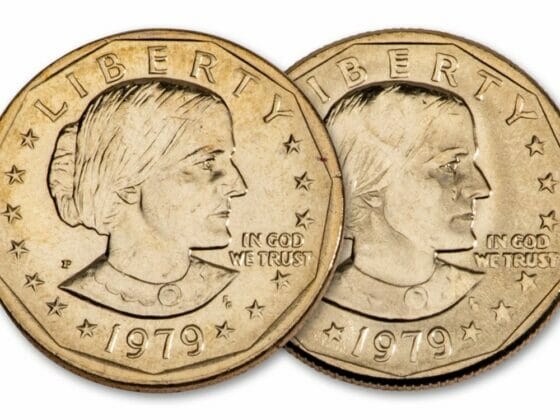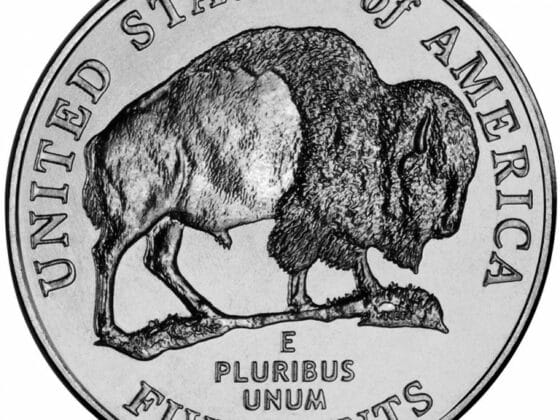Established in 1792, the U.S. Mint began the production of dimes four years later, in 1796. Over the centuries, these coins have undergone six major design transformations, with the most recent one featuring Franklin Roosevelt, introduced in 1946. Each dime, beyond its monetary value, holds a deep-seated artistic appeal and historical import.
In this article, we shall explore the 1967 Roosevelt dime, its value, design, composition, history, and notable errors that mark it out as a unique piece in the annals of American numismatics.
Table of Contents
The 1967 Dime Design, Symbolism & Composition
Issued in 1946 to mark the birth anniversary of former President Franklin D. Roosevelt, the design of the 1967 dime held significant symbolism. The decision to feature Roosevelt on a dime was deeply meaningful, as he was the founder of the March of Dimes organization, which was established to combat polio, a disease he personally battled at 39.
This emblematic Roosevelt design superseded the renowned Barber dime, a coin that enjoyed a near three-decade stint prior to its discontinuation. The artistic hand behind the new dime was none other than John Sinnock.
The 1967 Dime Design
The Obverse side

The obverse of a 1967 dime is elegant and simple. It features a lifelike leftward-facing representation of Franklin Roosevelt with the word LIBERTY inscribed in front of his face. The US motto, IN GOD WE TRUST, is placed on the bottom left, and you can see the year 1967 at the bottom right. The designer’s initials are right next to the year.
The Reverse side

The reverse side of the coin presents a stunning and profound portrayal of core American values, setting it apart in the annals of U.S. numismatic history. Displayed from left to right are an olive branch, a torch, and an oak branch. The olive branch is emblematic of the continuous pursuit of peace, the torch radiates the enduring flame of liberty, while the sturdy oak represents strength, independence, and authority.
Interlaced between these evocative symbols are the Latin words ‘E PLURIBUS UNUM’, an influential U.S. motto that translates to ‘out of many, one’, underscoring the unity inherent in the country’s diverse states. Encircling the top of the coin is the inscription ‘UNITED STATES OF AMERICA’, with the coin’s denomination prominently marked at the bottom.
Related: Dimes Worth Money – The Small Coins with Big Value
The Transition from Silver to Copper-Nickel Composition
For a long time, the US used silver to make dimes. Due to widespread hoarding of silver money and the subsequent coin shortage, the government enacted the Coinage Act of 1965, discontinuing the silver dimes. The composition was changed to copper-nickel clad and has remained the same ever since.
Related: The 1965 Dime Value, History, Mint And Error List
The 1967 Dime Composition And Size
The Roosevelt dime is composed of 91.67% copper and 8.33% nickel which gives it that lustrous, silver-like appearance. It weighs 2.268 grams (0.02 ounces) and is 17.91 millimeters (0.7 inches) in diameter. The coin is reeded with 118 reeds and 1.35 millimeters (0.05 inches) thick.
The 1967 Dime Symbolism
A Glance at the Turbulent Events of 1960’s
The 1960s were indeed a tumultuous period in U.S. history, marked by numerous events. The country faced major challenges, such as the Cuban Missile Crisis, the assassination of President Kennedy, and the Vietnam War, along with the anti-war protests it sparked.
Simultaneously, the Civil Rights Movement and various social transformations were reshaping the nation’s socio-political landscape. It was a time of considerable division and uncertainty. Interestingly, these profound changes were mirrored in the modifications made to the country’s coinage during this era.
The Role of Coins in Reflecting Societal Changes
Currencies have mirrored the nation’s societal transformations ever since they were first invented. For example, the figures depicted on coins often represent the most important people in the country’s history, as well as the nation’s religious and spiritual values. The changes in the composition, materials, and minting process can indicate economic growth and development.
Coinage is also a powerful tool for propaganda and ideological messages, like in the case of Confederate money. Finally, coins can show the evolution of aesthetics and art, from primitive and simple to intricate and complex designs.
The 1967 Dime Minting and Circulation
The Roosevelt dime was first introduced in 1945, soon after President Roosevelt’s death. The coin was officially approved at the beginning of January 1946 and the production started later that month, on January 19th. The first dimes were put into circulation on January 30th, the anniversary of Roosevelt’s birthday. Over two billion of these coins were minted in Philadelphia in 1967.
The public feedback was mostly positive, with the exception of Roosevelt’s political opponents and their supporters.
The various mints involved in producing the 1967 dime
The main US Mint is located in Philadelphia and it is the largest mint in the world. Other locations where the US produces coins are Denver, San Francisco, and West Point. Although the majority of the coin production is distributed between Philadelphia, Denver, and San Francisco, the dimes minted in 1967 were made only in Philadelphia.
1967 Dime No Mint Mark
Dimes minted in 1967 don’t have a mint mark because the Philadelphia Mint didn’t use them at the time. Therefore, you won’t have a problem discerning the origin location of your dimes from this year. In total, 2 244 007 320 ten-cent coins were produced in 1967.
Understanding mintage numbers for circulation coins
Mintage figures can give valuable insights into different aspects of the coins. Low mintage figures indicate a probable scarcity of the coins, making them more appealing for collectors and consequently more valuable.
Conversely, high mintage figures suggest that the coins are readily available, decreasing their price on the open market. Furthermore, the amount of coins minted in a certain year can reveal investment potential. If the numbers are low, it’s a good idea to invest in a number of those coins as they are likely to be valuable in the future.
The 1967 Dime Value
Today, most 1967 dimes carry minimal value, with prices increasing with the coin’s condition. High-grade dimes can fetch between $10 and $300. A high-quality graded MS68FB ‘full band’ 1967 dime reached an auction price of $1,440 in 2020.
Factors that affect the value of a 1967 dime
The value of your 1967 dime can significantly vary depending on several factors.
Scarcity
The rule of thumb in the numismatic world is that rarity determines the value. The more limited the variation of your coin is, the more valuable it will be. Regular 1967 dimes are rarely worth more than their face value, but those that are difficult to find command premiums.
Condition
The condition of a coin contributes to its scarcity as well. Old coins are seldom found in perfectly uncirculated states, so if you have a dime from 1967 that looks like it just exited a mint, consider yourself lucky!
Demand
Finally, the worth of your 1967 dime will depend on the current demand on the market. You may sell a coin for $300 but the same variety of that coin with the same grade may be ten times more expensive several months or years later. Before selling or purchasing a coin you think is precious, do extensive market research and investigate the trends to get the best price you can.
The 1967 Dime Error List
Mint errors are another factor that can increase the value of your coin because they are relatively rare. Sometimes they are easy to spot but at times you will need to take your coins to a professional coin grader to authenticate them. If you are a newbie this is the best action to take as you may not be acquainted with all the possible errors that can occur in certain currencies and varieties.
The 1967 Dime Clipped Planchet Error

The clipped planchet is one of the most interesting mint errors out there. It is also the easiest to spot; as the name says, a part of the coin is missing from these specimens.
Dimes from 1967 with this mistake are relatively easy to find. The errored dimes are worth anywhere between $0.15 to $100, depending on the condition of the remaining metal.
The 1967 Dime Double Die Error

The double die is an error that can affect both the obverse and the reverse of a coin. Due to mistakes in the manufacturing process, the whole or parts of the design can appear double. This mistake is not always easy to spot, so it’s important to inspect your coin carefully or take it to an expert. 1967 dimes with a double die can sell for $20 to $100 +.
The 1967 Dime Off-Center Error

This error occurs when the dies and planchets are misaligned, resulting in an off-center design. The severity of the mistake varies but it is typically not challenging to recognize it.
The 1967 Dime Die Crack Error

The dies that strike the design onto the planchets are put through substantial pressure daily. This can cause breakages and damages that then transfer to the coins, leaving behind a distorted picture. The coins with die cracks sell for $50 – $1000+, depending on the condition of the specimen and how severe and interesting the error is.
Conclusion
In conclusion, the 1967 Roosevelt dime serves as a tangible reflection of the era’s poignant and tumultuous historical events, encapsulating crucial aspects of America’s cultural and political fabric. Over two billion of these coins were minted in Philadelphia in 1967, ensuring their plentiful availability even today.
As such, their monetary value typically remains modest, often ranging up to a few dollars, unless they are in pristine condition or exhibit a rare error. Nevertheless, their true worth transcends mere financial consideration, making them a valuable addition to any numismatic collection.











